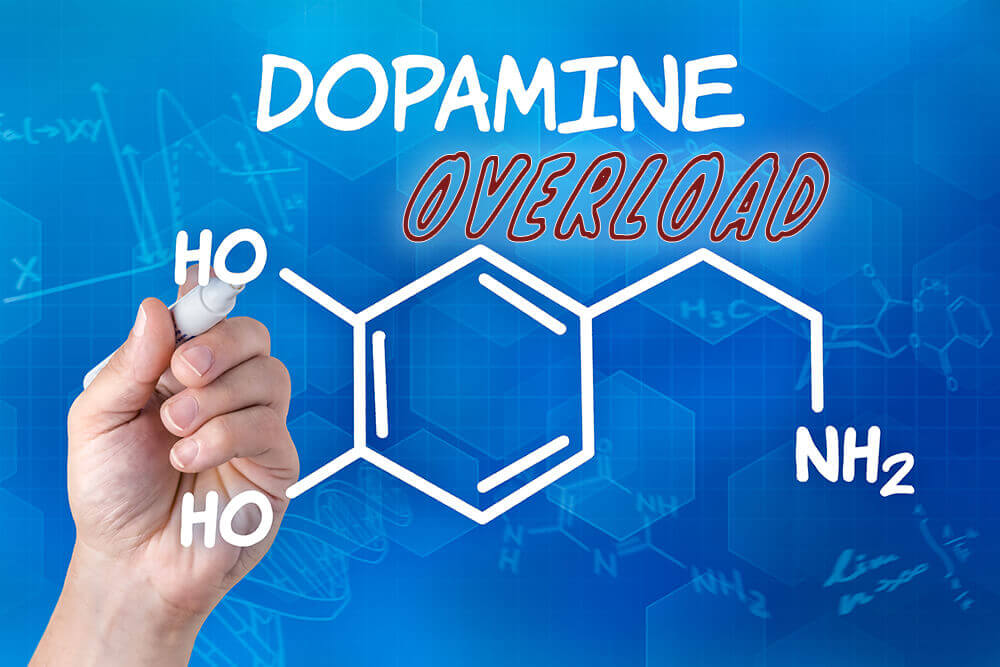
by Brad Huddleston
You know that feeling you get during a really good kiss?
Well, that euphoric sensation comes from neurochemicals in the brain, especially dopamine[1], a neurotransmitter that’s rewarding you with those emotional feelings of joy when it arrives in the pleasure center of the brain known as the nucleus accumbens[2], which is part of the reward pathway.[3] In other words, when we engage in high stimulating activities, dopamine is released into the Autobahn of the brain.
We are then “rewarded” with feelings of pleasure.
Sometimes these rewards are healthy, and sometimes they are addictive. In terms of addiction, a small amount of dopamine from an activity can be healthy, but continuous large amounts are addictive[4] and, therefore unhealthy.
In terms of brain health, it’s one thing to receive the “happy hormone” as a result of a smooch from your pet, child, or spouse, and it’s an entirely different thing to be rewarded with it from illicit drugs as well as digital drugs, which are perfectly legal. What makes my message about digital addiction incredibly challenging is that there is no stigma attached to video games, social media, Netflix binging, etc. like there is with cocaine and heroin.
To further complicate matters, the use of digital drugs is encouraged by the education systems of the world, youth groups, churches, and the culture in general. The problem is that the dopamine levels generated by both illicit and digital drugs are extremely high—high enough to cause a literal dependency. Until we have a paradigm shift in the way we think about digital activities, the problem will only worsen.
It is not my intention to label all digital activities as digital drugs, but the truth is, many that we don’t consider harmful, are. In future articles, I will attempt to distinguish between healthy and unhealthy uses of our devices, not throw all of them away.
Technically speaking, just about anything can be addictive. However, lower stimulating activities such as reading books (ones printed on paper), a friendly in-person, face-to-face conversation, or listening to your favorite music[5] usually yield non-addictive amounts of dopamine. In other words, these are generally healthy activities in which to engage regularly. Perhaps you noticed that these activities are all analog, or non-digital. You might be thinking, “What about the music coming from my phone? Isn’t that a digital activity?”
Well, yes and no.
Even though the music emanates from a digital source, it’s analog when it goes into your ears. That would be a potential good use of technology—so long as you’re not staring at the screen and doing other digital activities simultaneously.
High stimulating activities such as video game playing, compulsive use of social media, gambling, ingesting cocaine, heroin, alcohol, or marijuana, causes the brain to release high levels of dopamine in the nucleus accumbens, thus producing blissful emotions. As a person continues to overstimulate the brain with traditional or digital drugs, the brain builds up a tolerance.
In other words, it gets used to that activity, and to continue feeling high, the person must do more and more of that activity continuously.[6] This is where the addiction begins. Lesser stimulating activities, such as a hug, a face-to-face conversation, prayer, Bible reading, sermons, or even traditional sports, can become boring. Those activities do not produce enough dopamine to overcome the tolerance that has been built up in the brain. In other words, a drug-abuser becomes emotionally numb to activities of lesser stimulation.
When a person stops the drug, he or she experiences withdrawal, which results in symptoms that include anxiety and depression.[7]
As a person continues these activities, serotonin, begins to decrease. Serotonin is a hormone in the brain partially responsible for feelings of satiation, or contentment.[8] Decreased levels of serotonin are also associated with depression.[9]
The good news is that the brain can reset. What worries me is that the necessary increased use of technology during the COVID-19 Pandemic, along with the unnecessary time spent on devices, might be too much for our brains to recover from fully.
Only time will tell.
[1] Britishcouncil. “What’s in a Kiss? The Science of Smooching.” British Council, www.britishcouncil.org/voices-magazine/kiss-science-smooching. Accessed Feb. 20, 2020
[2] “Understanding Addiction.” HelpGuide.org, 17 Feb. 2020, www.helpguide.org/harvard/how-addiction-hijacks-the-brain.htm. Accessed Feb. 22, 2020.
[3] National Institute on Drug Abuse. “4: The Reward Pathway.” NIDA, National Institute on Drug Abuse, Feb. 2016, www.drugabuse.gov/publications/teaching-packets/understanding-drug-abuse-addiction/section-i/4-reward-pathway. Accessed Feb. 23, 2020.
[4] Hirschman, David. “Your Brain on Drugs: Dopamine and Addiction.” Big Think, Big Think, 6 Oct. 2018, bigthink.com/going-mental/your-brain-on-drugs-dopamine-and-addiction. Accessed Feb. 23, 2020.
[5] Dolan, Eric W. “Listening to the Music You Love Will Make Your Brain Release More Dopamine, Study Finds.” PsyPost, 2 Feb. 2019, www.psypost.org/2019/02/listening-to-the-music-you-love-will-make-your-brain-release-more-dopamine-study-finds-53059. Accessed Feb. 20, 2020.
[6] “Tolerance and withdrawal.” YouTube video, 00:00-05:32. June 25, 2014. https://youtu.be/3vKLU5_Hgco, accessed June 24, 2020.
[7] Ibid.
[8] “Reward pathway in the brain.” YouTube video, 8:24. June 25, 2014. https://youtu.be/YzCYuKX6zp8, accessed June 24, 2020.
[9] “Serotonin.” Serotonin | Endocrine Society, The Hormone Health Network, www.hormone.org/your-health-and-hormones/glands-and-hormones-a-to-z/hormones/serotonin.
This article is from Brad’s upcoming book, Digital Rehab: Digital Detox and Beyond. More about Brad’s work can be found at bradhuddleston.com.





